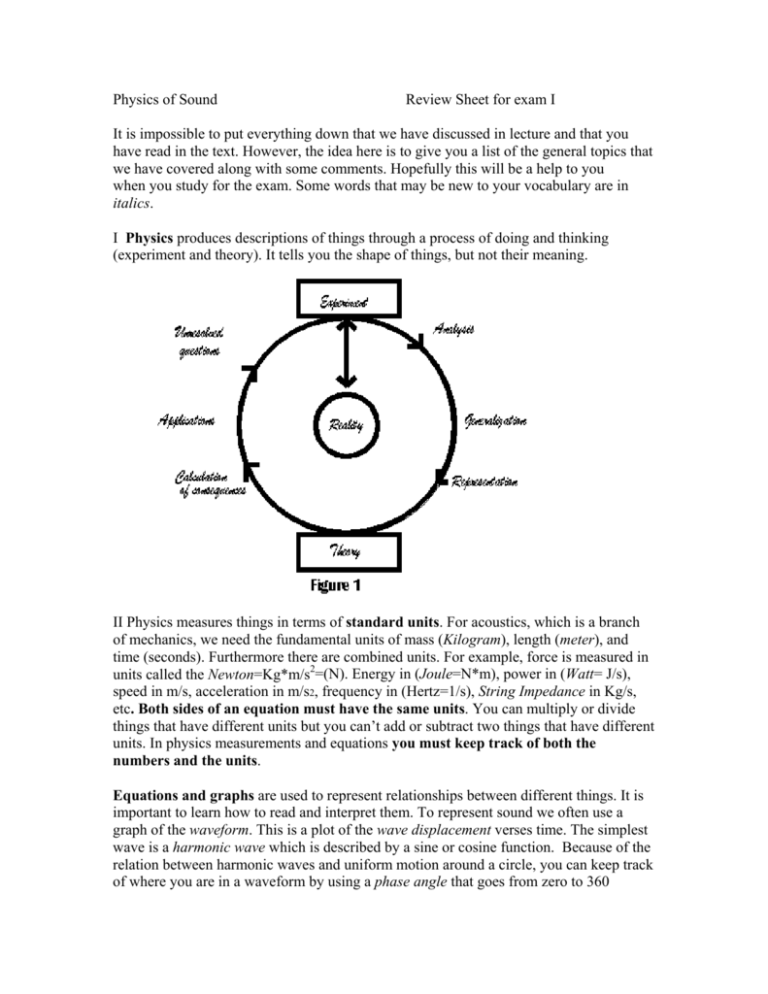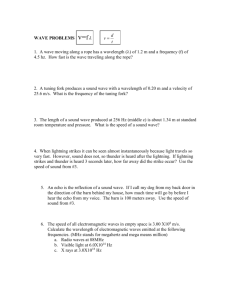Physics of Sound Review Sheet for exam I It is impossible to put
advertisement

Physics of Sound Review Sheet for exam I It is impossible to put everything down that we have discussed in lecture and that you have read in the text. However, the idea here is to give you a list of the general topics that we have covered along with some comments. Hopefully this will be a help to you when you study for the exam. Some words that may be new to your vocabulary are in italics. I Physics produces descriptions of things through a process of doing and thinking (experiment and theory). It tells you the shape of things, but not their meaning. II Physics measures things in terms of standard units. For acoustics, which is a branch of mechanics, we need the fundamental units of mass (Kilogram), length (meter), and time (seconds). Furthermore there are combined units. For example, force is measured in units called the Newton=Kg*m/s2=(N). Energy in (Joule=N*m), power in (Watt= J/s), speed in m/s, acceleration in m/s2, frequency in (Hertz=1/s), String Impedance in Kg/s, etc. Both sides of an equation must have the same units. You can multiply or divide things that have different units but you can’t add or subtract two things that have different units. In physics measurements and equations you must keep track of both the numbers and the units. Equations and graphs are used to represent relationships between different things. It is important to learn how to read and interpret them. To represent sound we often use a graph of the waveform. This is a plot of the wave displacement verses time. The simplest wave is a harmonic wave which is described by a sine or cosine function. Because of the relation between harmonic waves and uniform motion around a circle, you can keep track of where you are in a waveform by using a phase angle that goes from zero to 360 degrees (zero to 2π radians). Vibration frequencies f are measured in cycles-per-second (Hertz) or in phase-angle per second ω (angular frequency in radians per second) ω=2πf. The time it takes for one cycle of a vibration is called its period. The period is related to the frequency by the simple formula T=1/f. The most complicated representation of sound that we have considered is the spectrogram. The spectrogram is an analysis of the sound power at various frequencies as a function of time. Analysis means you take apart the total sound into its component waves at various frequencies. For the spectrogram plot one axis is time and the other axis is frequency. Sound power is indicated by the color on the plot. See the Friday 4 worksheet for an example. III Basic mechanics. Work is force times distance and has the same units as energy. Power is force times speed. Impedance is the ratio of the force to the speed. You can do the same work either with a large force and a small displacement or with a small force and a large displacement as long as the product of force times displacement is the same (because work is force-times-displacement). An impedance transformer (like a lever) does not do work for you, but it can change the way that you do work – by changing the ratio of force to motion. The basic equation of mechanics is F=ma : to accelerate a mass m with acceleration a you need a force F. Mechanics is the science of understanding force and motion. IV Simple harmonic motion. Many sounds are produced by vibrations. The simplest and most common kind of vibration is simple harmonic motion. It requires two ingredients: mass and a linear restoring force. A simple harmonic oscillator, when struck, will oscillate with harmonic motion. That means it has a waveform given by a sine or cosine function at a special frequency called its natural frequency. All simple harmonic oscillators can be described by a return force per unit displacement (in mechanics this is the spring constant for a spring represented by the symbol k with units N/m) and by a mass ( symbol m with units kg). Given these you can calculate the natural frequency using: k ωres = 2π f res = m Even a small force can produce a large motion for a simple harmonic oscillator if the force oscillates at the natural frequency (this means that the impedance is low). When an external force shakes an object at its natural frequency we observe resonance (large amplitude motion). At resonance you can easily transfer energy to a simple harmonic oscillator – as in the case of the glass beaker broken by sound from a loudspeaker. In simple harmonic motion there are two forms of energy: kinetic energy – the energy of motion – which is KE= ½ mv2 and potential energy (stored energy in the spring) which is PE=½ kx2. During oscillation energy is exchanged back and forth between these two forms and only slowly escapes through friction and becomes heat in the environment (this loss of energy results in a decrease in the amplitude called damping). However, the frequency of simple harmonic motion does not depend on the amplitude. V Wave motion. Wave motion occurs when you have the right kind of medium. For sound, you need a medium which is like many small simple harmonic oscillators connected together. Media that support sounds waves have a certain density of mass and a certain restoring force. Normally the restoring force is linear – proportional to how much the material has been compressed or decompressed. Because there are many kinds of wave motion there are a number of concepts that have been invented to describe waves. We discussed speed ,type (longitudinal or transverse) polarization (for transverse waves), impedance, frequency and wavelength, amplitude, and intensity (power). As in the case of the simple harmonic oscillator, wave motion at a definite frequency is described by a waveform that is a sine or cosine wave. However, harmonic waves also have a waveform in space with a definite wavelength which depends on the frequency. Also, because of linearity (this means that restoring force is linearly proportional to the wave displacement) you can analyze complex waveforms in terms of simple parts. The net result of two sounds is simply to add the displacement caused by each one separately (this is called superposition). The speed of a wave is related to the mass and restoring force in a similar way to how the natural frequency of a simple harmonic oscillator depends of the mass and spring constant. For example, for a string, the restoring force is due to the tension force F (in Newtons), and the mass is in the density W (in kg/m) of the F string. The wave speed for these transverse waves is S = . Unlike simple harmonic W motion, waves can travel at many frequencies and have a wavelength that varies depending on the speed of sound and the frequency · . Wave power depends on the wave impedance and the square of the particle velocity according to P=Zv2. The wave impedance for a string is Z = F ⋅W Where the mass density (mass per unit of length) of the string is its mass divided by its M length W = . L Although wave motion can be complicated, you can use simple principles to predict what is going to happen. If the wavelength of a wave is short compared to the objects encountered you can use the ray theory – this says that sound spreads out along lines. According to ray theory, large objects will have a sound shadow. The ray theory is useful when you want to understand reflection and also refraction – the deflection of sound due to a temperature gradient. However, it does not work when you have diffraction. If an object or a doorway is about the same size or smaller than the wavelength then the waves will diffract around corners and there will not be a shadow. One way to understand diffraction is in terms of Huygen’s principle. Interference does not mean that one wave blocks another, but rather that the total wave amplitude at any location will be the sum of the amplitudes of several waves that may have taken different paths or be at different frequencies. Beats are one example of an interference effect. The Doppler effect occurs when either the source or the receiver of sound is moving. Although the net effect is similar (for example the frequency heard increases if the sender moves toward the receiver or if the receiver moves toward the sender) the two kinds of Doppler effect are very different. The formula relating frequency to wavelength only works in the frame of reference of the air (the wave medium). When the source moves, both the frequency and the wavelength of the sound in the air change. When the receiver moves, nothing changes in the air, but the receiver hears an altered frequency. See the notes from Friday 4. For a moving source the Doppler effect is described by: 1 You can see that if a source moves at the speed of sound this equation fails (the frequency ratio goes to zero which means that fair must be infinite, or a singularity) – this means that the theory breaks down. What happens is that you get a shock wave if a source moves that fast. For a moving receiver you have: 1 VI Waves in Air Sound travels as a longitudinal wave in air with a velocity given by Τ 331.3 0.6 Μ The second part is an approximate formula that works well for most of the temperatures that you will experience. The speed depends on the mass of the molecules m, their shape γ, and their temperature kT. The main thing that affects the sound speed on earth is a change in temperature. Because water molecules have a different shape and mass than oxygen and nitrogen (the gasses that make up most of the atmosphere), there is a slight dependence on humidity. VII The slinky is a special medium that supports both transverse and longitudinal waves. When you stretch it out you change both the mass density and the tension. See Friday 3 worksheet. VIII Impedance and reflections. A sudden change in impedance causes a reflection. Energy transfer is perfect when impedances are matched. See the notes on Impedance from the lectures notes. In addition there are supplementary lecture notes on impedance. Z1 − Z 2 Z1 + Z 2 This equation tells you the amplitude of the reflected wave AR if you know the amplitude of the incident wave AI and the impedances of the incident wave medium Z1 and the impedance of the medium that the wave runs into Z2. AR = AI Equation summary sheet: Some definitions: angular frequency ω=2πf , Basic mechanics : · T=1/f ( f is frequency) F=ma Newton’s second law. Simple harmonic motion: ωres = 2π f res = Waves: period k m PE= ½ mv2 KE=½ kx2 relation between frequency, wavelength and the speed of a wave. Waves on Strings: S = F W W= M L Z = F ⋅W Waves in Air: Τ 331.3 0.6 Μ Pressure is force per unit area and density is mass per unit volume. Doppler Effect (moving source): 1 Doppler Effect (moving receiver): 1 Impedance and reflections: Z − Z2 AR = AI 1 Z1 + Z 2 P=Zv2 Wave power equals the particle velocity squared times the impedance.








